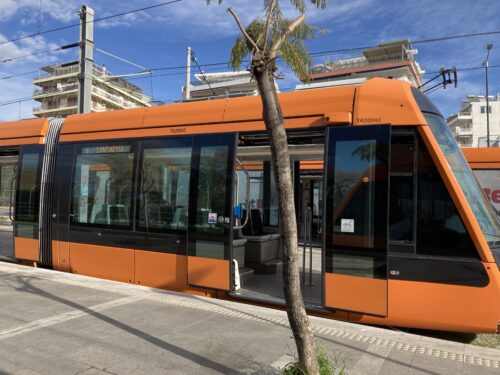I recently read an article by The New York Times about how to reduce our carbon footprint, and it got me thinking about my own personal impact on this world I live in.
Professionally, I consider it an awesome responsibility to be a part of the climate crisis solution every day.
While the work that we do at American Green doesn’t involve implementing some of the most thought-of next steps for reducing carbon emissions, such as installing solar panels or producing electric vehicles, we do have a unique role to play.
Deforestation and forest degradation is the second leading cause of carbon pollution, causing 20% of total greenhouse gas emissions. FSC certification ensures that products come from responsibly managed forests that provide environmental—as well as social and economic—benefits.
Personally, I was deeply curious to learn more about the environmental impact of some of my day-today decisions, such as the decision to travel.
So I decided to do a comparison between my normal home life vs. my recent European remote-work excursion.
❝ A carbon footprint is the total amount of greenhouse gases (including carbon dioxide and methane) that are generated by our actions. ❞ — The Nature Conservancy
What To Know Before You Compare

Firstly, I took stock of a few things I already knew about home vs. travel carbon impact:
- A person living in the U.S. has an average carbon footprint that is much higher than anywhere else in the world.
- Air travel is one of the largest contributors to global carbon emissions—so much so that there’s a no-fly movement gaining momentum.
Based on these two things alone, I knew I was in for an interesting ride (pun intended).
Secondly, I wanted a better understanding of the main lifestyle choices that have the greatest impact on my personal carbon footprint.
So I sought out (and found) a great carbon footprint calculator developed by The Nature Conservancy (more on that below).
- What I learned is that calculating one person’s footprint is way more complicated than simply deciding to use a different kind of light bulb. From what I eat to the type of transport I choose, all of that can move the needle up or down.
- So I decided that my goal for my home vs. travel carbon comparison wasn’t to get exact numbers, especially since I didn’t keep track of all that I ate, the mileage I drove, etc., during my trip.
My hope was to get a better understanding of how my decision to travel—and all the ways my abroad lifestyle differed from my homebound one—affected my carbon output.
❝ While real solutions will require action on a global scale, there are choices you can make in your day-to-day life to lessen your personal impact on the environment. ❞ — Livia Albeck-Ripka, The New York Times
How To Calculate Those Carbons

To get a better idea of what goes into calculating your carbon footprint, hop onto a carbon calculator and input your numbers.
Step 1: Find a calculator.
The Nature Conservancy’s interactive and easy-to-use carbon footprint calculator is free for anyone to use.
Step 2: Gather the facts.
Calculating your carbon emissions requires some specific data, so have these pieces of annual habits and expenses at the ready before you fire up that calculator:
- household (# of members and annual gross income)
- travel (mileage driven and flown + miles per gallon for each car)
- home (electricity, gas and water usage + home square footage)
- food (calorie consumption of proteins, grains, dairy, fruits & veggies and snacks)
- shopping (expenses on goods and services)
Step 3: Input those numbers.
If you have the facts in front of you, inputting the numbers is quick. And before you know it, you’ll be presented with your carbon footprint and how you compare with similar households.
❝ To have the best chance of avoiding a 2℃ rise in global temperatures, the average global carbon footprint per year needs to drop to under 2 tons by 2050. ❞ — The Nature Conservancy
My Carbon-Compare Findings

Going through this carbon comparison exercise proved to be an eye-opener for me.
- When I’m at home, I have the time, resources and energy to actively find solutions to reducing my carbon footprint.
- If I want an energy-efficient light bulb for my home, I can go to the store and buy it.
- If I want a full vegan meal, I know where the nearest vegan restaurant is.
- If I want to recycle a glass bottle, I can put it in my curbside recycling.
- When I’m abroad, I have limited time and fewer choices, so I must compromise.
- The Airbnbs I stayed in are not my home, nor do I travel with light bulbs, so I use what is there.
- Finding the food I crave and am used to isn’t as easy in an unfamiliar place, so I eat what’s available.
- If the city I’m in doesn’t offer glass recycling, into the trash that bottle must go.
Below are a few other comparisons I noted while traveling abroad. ⬇️
| HOME 🏠 | ABROAD ✈️ |
|---|---|
| TRAVEL BY LAND | |
| ⬇ Minimal daily commuting
Because I work for a remote-first company, I don’t commute to work, which really cuts down on daily travel and CO2 emissions. ⬇ Access to electric vehicle (EV) When I do need to drive somewhere, such as to the store or local activities, I drive my electric Nissan Leaf. |
⬆ More daily travel
Because my partner and I were in Europe to see the sights, it’s understandable that we would commute a lot more than we were used to. ⬇ Use of mass transit However, the upside is that we used mass transit more than at home, such as the metro, trains and buses. |
| TRAVEL BY AIR | |
| ⬇ Minimal air travel
Prior to this trip, I flew on average less than 1x per year. I’ve also only taken a few overseas flights in my life, including the one that brought me to the U.S. as an infant! |
⬆ Multiple flights in seven weeks
Time limits and distance were a challenge, which meant we took multiple flights in a short amount of time: Detroit to Paris ⇢ Paris to Athens ⇢Athens to Rome ⇢ Rome to Lisbon ⇢ Lisbon to Dublin ⇢ Dublin to Boston ⇢ Boston to Detroit. |
| GREENER EATS | |
| ⬇ Vegetarian diet
Before I reached adulthood, I declared to my parents that I was a vegetarian. Ever since, I’ve maintained a vegetarian lifestyle (with the occasional fish dish), which has a lighter impact on the environment than a meat diet. |
⬇ Vegetarian diet
Fortunately, we prepared most of our meals from our Airbnbs, and I could continue to eat vegetarian meals. (However, I did notice a lot more meat being sold and consumed, especially pork.) |
| ECO-FRIENDLY AMENITIES | |
| ⬇ Smart home energy
At home, I live with my partner in a home he built, which was specifically designed to be energy efficient, including LED light bulbs and a smart thermostat. ➡ Carbon-neutral heat We heat the house with a masonry wood-burning stove in the winter, using locally sourced wood—making this form of heating our home carbon neutral. |
⬆ Inefficient home lighting
All the Airbnbs we stayed in seemed to use incandescent light bulbs, which are notoriously inefficient. ➡ Energy savings that felt unsafe Most of the Airbnbs we stayed in did not have central heat, so they were very cold. Additionally, hallways and stairwells were not well lit, often on a timer that went off before you were out of the area. Even though these practices may have saved on electricity, they made us feel less safe. |
| RECYCLING ACCESS | |
| ⬇ Recycling that I understand
My home base in the U.S. is Ann Arbor, MI, and we enjoy a healthy recycling program that’s well-documented and easy for me to understand. |
⬆ Recycling that was confusing
Countries varied in the accessibility of their recycling containers: • In Athens, there were no containers. |
Final Thoughts

In an ideal world, it would be wonderful to travel with everything that would allow me to maintain the same (or better!) carbon footprint at home and abroad.
While improvements are being made when it comes to more efficient planes, greener lodgings, etc., the fact remains that travel does have a negative environmental impact when it comes to carbon emissions.
For me, it’s vitally important to remain aware of what the potential cost is when I travel to check off some of those bucket list items so that I can make the best choices possible.
As psychologist Nathanial Branden once said, “The first step toward change is awareness.” And in response, I quote actor Rita Wilson: “Awareness is empowering.”
❝ Awareness is empowering. ❞ — Rita Wilson
About the author: Sarah Dean is an AGC independent consultant. In addition to traveling, Sarah enjoys dancing, hiking, and spending time with family and friends. Learn more about Sarah on our About Us page.
Photo credits: Sarah Dean, Shawn Batt
Got questions about FSC certification?
